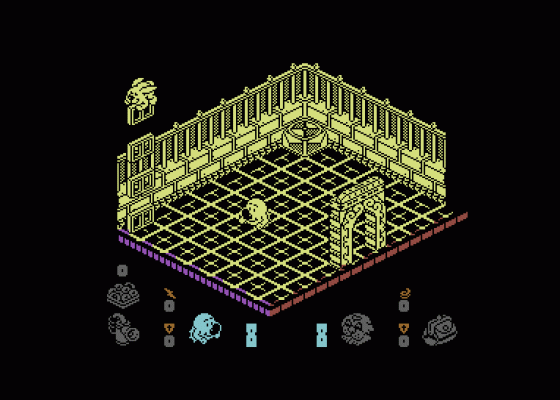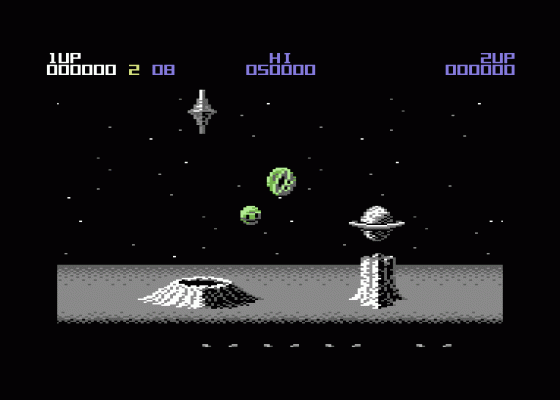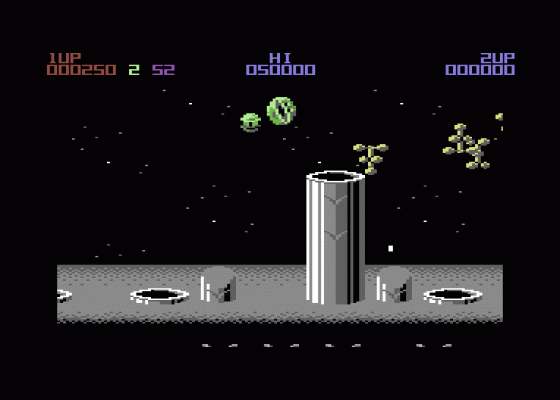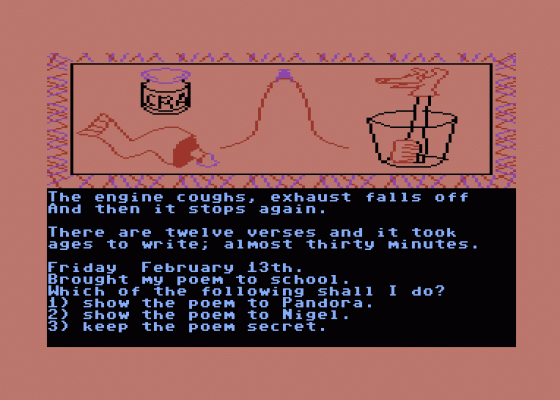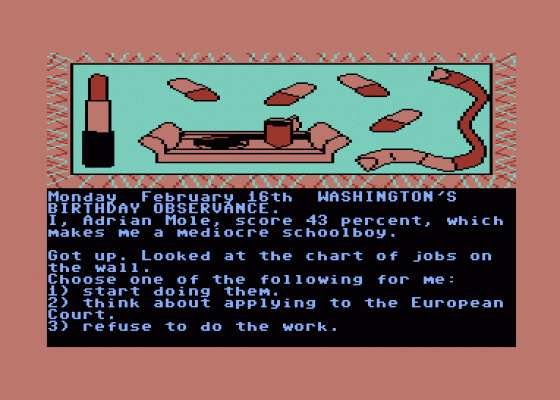
Commodore Format
 1st May 1994
1st May 1994
Categories: Review: Software
Publisher: Alternative
Machine: Commodore 64/128
Published in Commodore Format #44
Secret Diary Of Adrian Mole
There have been those who claimed that the book this game was based on prepared them for adulthood. As far as I was concerned, it was just a warning about how truly dire life could become if you eat too much marmalade. It was very funny, though, whichever way you looked at it.
Thankfully, this is a book that the programmers had the good taste to turn into a text adventure rather than a platform game, a decision that has almost definitely saved them from probably the most scathing review the world has ever seen.
The first thing that strikes you about this game is that a good deal of originality was used, and that the programmers haven't just stuck to the plot of the book into an adventure-writing utility and hoped for the best. The second thing that strikes you about Mole is that it wasn't written by Sue Townsend. If you've ever played Hitch-Hiker's Guide, you'll know all about the benefits of Douglas Adams having written it. With Mole, things aren't as easy, but you'll have an entertaining time nonetheless.
As with most commercial text adverture releases, the parser is reasonable, accepting most of the usual commands, and not getting in the way of the plot too much.
The only thing that you've really got to decide before you rush out to your nearest EDOS stockist is whether you actually like text adventure games - this is a perfectly adequate specimen, but if you don't like that style of game in the first place, you're wasting your time - this is the kind of game you'll either like or loathe, and if you'd prefer not to spend your free time reading, there isn't much here for you.
Head Over Heels
Way back in the mists of time, there was Ultimate software. Though they had nothing to do with this particular game, they produced a natty little title by the name of Knight Lore.
The twist that made Lore not only so popular but so valuable to the history of computer gaming was that the entire thing was done in isometric 3D. For those who aren't up on their maths, that's the type of 3D where every line has either a 30 or 60 degree angle, and you wander around not really sure whether a block is right in front of you or at the other side of the screen and very high up. More recently, this game style has crept into other big titles on the consoles, but we know we did it best when Jon Ritman and Bernie Drummond wrote Head Over Heels.
Head Over Heels is the story of two dogs, namely Head, who is incredibly light, enabling him to jump quite high, and who has little wings under his arms which help him glide on his way down, and Heels, who has no such ability, but can move like greased lightning (whatever that is!).
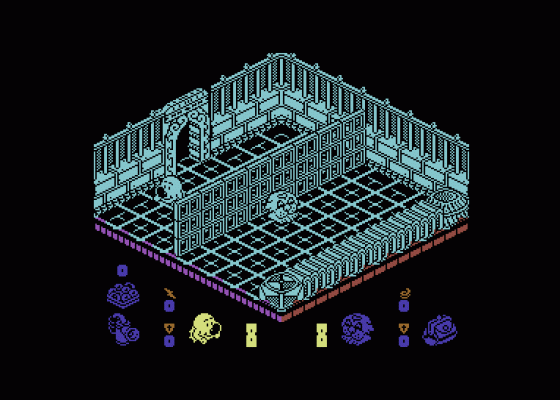
Anyway, these two canines start off stuck in different parts of the enormous game area - what's worse is that they're actually in the same room to start off with, but separated by a large wall, and so have to use different doors, which takes them wildly out of each other's way. One of the main elements of the game is the chase to actually unite the pair, so that Head sits atop Heels, and the two can act as one.
This game is made even more interesting by a number of gameplay additions that earlier isometric titles didn't see. First, these are several special devices scattered about the place that when collected will give even more power to the player. The second addition to the theme comes in the form of having two characters to control - you basically switch between the two whenever you feel like it, and so have, in effect, two different games to play for quite a while.
As for standard game criteria, Head Over Heels is absolutely massive, with some incredibly well thought-out puzzles that are not only fun but mentally taxing. The graphics are some of the best to be found on the 8 bits, courtesy of Bernie Drummond - a name that carries weight in the decision to buy any game.
All in all, Head Over Heels is definitely a game to rush down to your local EDOS stockist and order.
Wizball
You may think religion is all about going to church and being kind to people in the hope that you'll achieve some kind of immortality (wake up), but it's also been the cause of most major wars in the 20th century. Religion doesn't have to be anything incredibly holy, by the way - you just have to believe in something.
The reason I'm telling you this is because there was a religious war in Britain about five years ago - though the event didn't receive much press publicity at the time - in which an entire town folded in on itself and started fighting over one small fact: is Wizball a platform game or a shoot-'em-up?
The game itself is all about bouncing around a horizontally-scrolling landscape, filling cauldrons of different-coloured potions in an effort to complete the level. However, there are things you can kill by shooting at them. There are also platforms in the form of pillars, and things to avoid in classic platform fashion. So some say that this is just another platform game in which you shoot things, whereas others point out that there are hardly any platforms and, when you do come across them, they're obstacles rather than something to stand on. It's usually around now that the first group of people slowly draw knives and the second ease fresh clips into their handguns and stare group one out.
All this is actually irrelevant when we get down to is, as this is a game that, whether you believe it's a platform game or a small, brown, disgruntled antelope from Peru, you're bound to enjoy it. The action is constant, your reactions will definitely be tested, as will your brain. Basically what I'm saying is that Wizball's good, okay?






